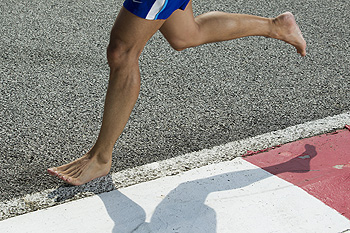 Some people who run barefoot feel like wearing shoes hamper their natural stride and can even cause pain. The heels strike the ground first for runners who wear shoes. This may produce a force of up to three times the body’s weight, which can lead to stress fractures and discomfort. Running barefoot generally causes the runner to land on the ball of the foot, generating less impact on the body. One advantage that barefoot runners have are shortened strides. This reduces the impact on their lower bodies. Because of this, landing becomes softer on hard surfaces. The feet may also be over-supported in running shoes. This may result in weaker muscles, because they’re not working as hard. While barefoot running may be acceptable for some, it is not for everybody. Consult with a podiatrist before you decide to try this form of exercise.
Some people who run barefoot feel like wearing shoes hamper their natural stride and can even cause pain. The heels strike the ground first for runners who wear shoes. This may produce a force of up to three times the body’s weight, which can lead to stress fractures and discomfort. Running barefoot generally causes the runner to land on the ball of the foot, generating less impact on the body. One advantage that barefoot runners have are shortened strides. This reduces the impact on their lower bodies. Because of this, landing becomes softer on hard surfaces. The feet may also be over-supported in running shoes. This may result in weaker muscles, because they’re not working as hard. While barefoot running may be acceptable for some, it is not for everybody. Consult with a podiatrist before you decide to try this form of exercise.
Barefoot running has its own share of benefits and disadvantages. If you have any concerns about your feet or ankles, contact one of our podiatrists from Sutera and Jones Surgical Podiatry. Our doctors will treat your foot and ankle needs.
Barefoot Running
The Impact of Barefoot Running
- Running without shoes changes the motion of your running, as most running is done by landing on the heel of the feet.
- Running barefoot requires a different way of running; the landing is done on the front part of the feet.
The Advantages of Barefoot Running
- When running and landing on the front feet, the impact on the feet and ankle is reduced; this can reduce stress injuries.
- It strengthens muscles in the feet, ankles and lower legs.
- Balance of the body is improved, and there is a greater sensory input from the feet to the rest of the body.
The Drawbacks of Barefoot Running
- No protection while running, makes it likely that runners will land on sharp objects and scrapes, bruises and cuts on the feet will result.
- Blisters may form.
- Possibility of plantar fascia problems.
- Risk of getting Achilles tendonitis.
So, what can runners do to make barefoot running safe? It’s best to make a slow transition from running shoes to barefoot running. Once the feet begin to adjust, try walking, then jogging and gradually increasing the distance. Minimalist running shoes may also be an option.
If you have any questions please feel free to contact one of one of our offices located in Media and Glen Mills, PA . We offer the newest diagnostic and treatment technologies for all your foot and ankle needs.
Read more about Barefoot Running